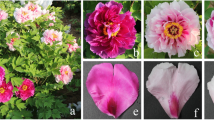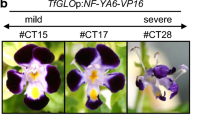Abstract
In order to generate new flower colors in lisianthus, a flavonolsynthase (FLS) coding sequence was isolated from lisianthus (Eustomagrandiflorum Grise.) using a petunia homologue (pCGP481) as a probe.The endogenous FLS mRNA transcript occurs early in petal development,concomitant with accumulation of flavonols in bud tissue, and ceases at onsetofanthocyanin pigment production. Southern DNA analysis indicated FLS as a memberof a multigene family in lisianthus. Transgenic plants of a purple floweredlisianthus line expressing antisense FLS under the control of the CaMV35Spromoter produced flowers more red in color (magenta) than the originaluntransformed plant. The transgenic plants also showed novel red pigmentation(cyanidin) in early stage buds as well as deeply colored pistils, andaccumulated dihydroflavonols at the expense of flavonols. Further, analysis ofthe progeny of crosses between the primary transformants and a deeply pigmentedpurple variety (Wakamurasagi) showed this novel phenotype to be stablyinherited. Field trial assessment of antisense FLS plants indicated variationinthe petal and early bud phenotype although variation in the transgenic flowercolor was within the range normally seen in commercial cultivars grown undercommercial conditions.
Similar content being viewed by others
References
An G., Ebert P.R., Mitra A. and Ha S.B. 1988. Binary Vectors. In: Gelvin S.B., Schilperoort R.A. and Verma D.P.S. (eds), Plant Molecular Biology Manual. Vol. A3. Kluwer Academic Publishers, Dordrecht, pp. 1-19.
Bradley J.M., Davies K.M., Deroles S.C., Bloor S.J. and Lewis D.H. 1998. The maize Lc regulatory gene up-regulates the flavonoid biosynthetic pathway of Petunia. The Plant Journal 13: 381-392.
Bradley J.M., Deroles S.C., Boase M.R., Bloor S.J., Swinny E. and Davies K.M. 1999. Variation in the ability of the maize Lc regulatory gene to upregulate flavonoid biosynthesis in heterologous systems. Plant Science 140: 31-39.
Brouillard R. and Dangles O. 1993. Flavonoids and flower colour. In: Harborne J.B. (ed.), The Flavonoids: Advances in Research Since 1986. Chapman & Hall, London, pp. 565-587.
Burbulis I.E. and Winkel-Shirley B. 1999. Interactions among enzymes of the Arabidopsis flavonoid biosynthetic pathway. Proc Nat Acad Sci USA 96: 12929-12934.
Church G.M. and Gilbert W. 1984. Genomic Sequencing. Proc Natl Acad Sci USA 81: 1991-1995.
Davies K.M., Bradley J.M., Schwinn K.E., Markham K.R. and Podivinsky E. 1993. Flavonoid biosynthesis in flower petals of five lines of lisianthus (Eustoma grandiflorum Grise.). Plant Science 95: 67-77.
Davies K.M. and Schwinn K.E. 1997. Flower colour. In: Geneve R.L., Preece J.E. and Merkle S.A. (eds), Biotechnology of Ornamental Plants. CAB International, Wallingford, pp. 259-294.
Deroles S.C., Ledger S.E., Miller R.M., Davies K.M. and Given N.K. 1993. Transformation in Eustoma grandiflorum lisianthus. In: Bajaj Y.P.S. (ed.), Biotechnology in Agriculture and Forestry. Plant Protoplasts and Genetic Engineering 111. Vol. 22. Springer-Verlag, pp. 202-212.
Deroles S.C., Bradley J.M., Schwinn K.E., Markham K.R., Bloor S.J., Manson D.G. et al. 1998. An antisense chalcone synthase cDNA leads to novel colour patterns in lisianthus (Eustoma grandiflorum) flowers. Mol Breeding 4: 59-66.
Doyle J.J. and Doyle J.L. 1990. Isolation of plant DNA from fresh tissue. Focus 12: 13-15.
Elomaa P., Honkanen J., Puske R., Sepponen P., Helariutta Y., Mehto M. et al. 1993. Agrobacterium-mediated transfer of antisense chalcone synthase cDNA to Gerbera hybrida inhibits flower pigmentation. Biotechnology 11: 508-511.
Forkmann G. 1991. Flavonoids as flower pigments: the formation of the natural spectrum and its extension by genetic engineering. Plant Breeding 106: 1-26.
Forkmann G. 1993. Genetics of flavonoids. In: Harborne J.B. (ed.), The Flavonoids: Advances in Research Since 1986. Chapman & Hall, London, pp. 537-564.
Harborne J.B. and Sherrat H.A.S. 1961. Plant Polyphenols. 3. Flavonoids in genotypes of Primula sinensis. Biochem. J 78: 298-306.
Heller W. and Forkmann G. 1994. Biosynthesis of Flavonoids. In: Harborne J.B. (ed.), The Flavonoids: Advances in Research Since 1986. Chapman & Hall, London.
Holton T.A., Brugliera F. and Tanaka Y. 1993. Cloning and expression of flavonol synthase from Petunia hybrida. The Plant Journal 4: 1003-1100.
Johnson E.T., Yi H., Shin B., Oh B., Cheong H. and Choi G. 1999. Cymbidium hybrida dihydroflavonol 4-reductase does not efficiently reduce dihydrokaempferol to produce orange pelargonidin-type anthocyanins. The Plant Journal 19: 81-85.
Ledger S.E., Deroles S.C., Manson D.G., Bradley J.M. and Given N.K. 1997. Transformation of lisianthus (Eustoma grandiflorum). Plant Cell Reports 16: 853-858.
Lois R. and Buchanan B.B. 1994. Severe sensitivity to ultraviolet radiation in an Arabidopsis mutant deficient in flavonoid accumulation. Planta 194: 504-509.
Markham K.R. and Ofman D.J. 1993. Lisianthus flavonoid pigments and factors influencing their expression in flower colour. Phytochemistry 34: 679-685.
Markham K.R. and Hammett K.R.W. 1994. The basis of yellow colouration in Lathyrus aphaca flowers. Phytochemistry 37: 163-165.
Meyer P., Hedemann I., Forkmann G. and Saedler H. 1987. A new petunia colour generated by transformation f a mutant with a maize gene. Nature 330: 677-678.
Murashige T. and Skoog F. 1962. A revised medium for rapid growth and bioassays with tobacco tissue cultures. Physiol Plant 15: 473-497.
Nielsen K.M. and Podivinsky E. 1997. cDNA cloning and endogenous expression of a flavonoid 3′5′-hydroxylase from petals of lisianthus (Eustoma grandiflorum). Plant Science 129: 167-174.
Pelletier M.K., Murrell J.R. and Shirley B.W. 1997. Characterization of flavonol synthase and leucoanthocyanidin dioxygenase genes in Arabidopsis. Plant Physiology 113: 1437-1445.
Prescott A. and Martin C. 1987. Rapid method for the quantitative assessment of levels of specific mRNAs in plants. Plant Mol. Biol. Rep. 4: 219-224.
Shinners L.H. 1957. Synoposis of the genus Eustoma (Gentianaceae). Southwest Nat. 2: 38-43.
van der Krol A.R., Lenting P.E., Veenstra J., van der Meer I.M., Koes R.E., Gerats A.G.M. et al. 1988. An antisense chalcone synthase gene in transgenic plants inhibits flower pigmentation. Nature 333: 866-869.
Van der Meer I.M., Stam M., van Tunen A.J., Mol J.M.N. and Stuitjem A.R. 1992. Antisense inhibition of flavonoid biosynthesis in Petunia anthers results in male sterility. Plant Cell 4: 253-262.
van Eldik G.J., Reijnen W.H., Ruiter R.K., van Herpen M.M., Schrauwen J.A. and Wullems G.J. 1997. Regulation of flavonol biosynthesis during anther and pistil development, and during pollen tube growth in Solanum tuberosum. Plant J 11: 105-113.
Van Sumere C.F., Vande Casteele K., De Loose R. and Heursel J. 1985. Reversed-phase HPLC Analysis of Flavonoids and the Biochemical Identification of Cultivars of Evergreen Azalea. In: Van Sumere C.F. and Lea J. (eds), The Biochemistry of Plant Phenolics. Clarendon Press, Oxford, p. 17.
Vogt T., Wollenweber E. and Taylor L.P. 1995. The structural requirements of flavonols that induce pollen germination of conditionally male fertile Petunia. Phytochemistry 38: 589-592.
Winkel-Shirley B. 1996. Flavonoid biosynthesis: 'new' functions for an 'old' pathway. Trends in Plant Science 1: 377-382.
Winkel-Shirley B. 1999. Evidence for enzyme complexes in the phenylpropanoid and flavonoid pathways. Physiologia Plantarum 107: 142-149.
Author information
Authors and Affiliations
Rights and permissions
About this article
Cite this article
Nielsen, K., Deroles, S.C., Markham, K.R. et al. Antisense flavonol synthase alters copigmentation and flower color in lisianthus. Molecular Breeding 9, 217–229 (2002). https://doi.org/10.1023/A:1020320809654
Issue Date:
DOI: https://doi.org/10.1023/A:1020320809654




